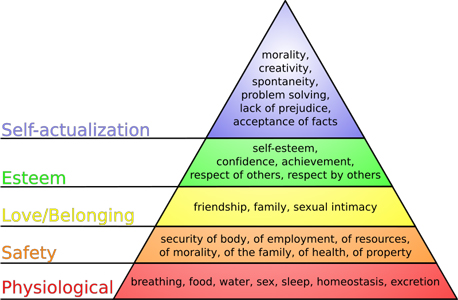![Lest We Forget Maslow]()
by Tara Joyce | Oct 29, 2008 | Self/Business Growth
I never want to come off smug or ‘elitist’ (it’s my favourite buzz word of the moment) when I write about Cultural Creativity. It is sincerely not my intention. The understanding our subculture shares is only possible because of the circumstances we were born under. Each of us has been fortunate enough to be born into a supportive enough environment that we are able to satisfy our most basic needs.
Because we have satisfied our lower layer needs, such as safety, we are able to focus on self-actualization thus helping us to cultivate a more conscious and aware mind. This mindset change invariably shaped our values into that of a Cultural Creative.
The Five Layers of Human Needs
The Hierarchy of Needs Model by Abraham Maslow

designed by J. Finkelstein
We are in no way better than any one else. We couldn’t possibly think that and truly be self-actualized. Each of us has simply been afforded the opportunity, through God or our own actions, to lead the most conscious life we can. For this reason alone, we need to work together so that every human, at the very least, can satisfy their most basic needs.
Keep this in mind about Maslow’s Hierarchy:
- people do not actually work through each stage one by one – we are much less structured in the way we satisfy our needs
- Maslow’s hierarchy can be arranged differently depending on the culture – for example, in Tibetan Buddhism, self-actualization would be a primary, and thus bottom of the pyramid, need
![Lest We Forget Maslow]()
by Tara Joyce | Oct 29, 2008 | Cultural Creativity
I love to read. It’s a passion. And now that I have learned a little about innerpreneurship and our Cultural Creative subculture, I am obsessed with learning more. Coupled with my own obsession, I recently had the pleasure of meeting my first mentor, Dr. Mishail Yanakiev, who has been filling my mind daily with information related to our movement.
The more I read, the more I am sure that there is a great cultural transformation underway. Slowly, people are changing their thinking. It is evident everywhere and it gives me hope.
People must have the desire to change, we can not make them. All we can do is lead by example and educate. Below are leading ideas in Social Science and Business, ideas that are spreading, ideas that further validate that our way of thinking is the future.
Changes in Social Science
Positive Psychology
Positive Psychology is a new branch of psychology that focuses on the empirical study of such things as positive emotions, strengths-based character, and healthy institutions. It’s purpose is to make the world a happier place, parallel to the way clinical psychologists have made the world a less unhappy place.
Penn State University and Dr. Martin Seligman are at the forefront of this new movement in Psychology. Their Authentic Happiness website has great resources if you want to learn more about this new field and has an extensive number of free questionnaires covering emotions, meaning, engagement and life satisfaction.
The questionnaires measure character strengths and aspects of happiness. For each one you take, the site keeps a record of your scores, so that you can return later and see how far you’ve progressed.
Penn State is also the first university in the world to offer a Masters in Applied Positive Psychology. If you feel like helping with their research they are currently looking for participants for their Postive Psychology research. Participation in the studies can be done completely online.
Another fascinating resource on Positive Psychology is BBC News’ site on The Happiness Formula.
Changes in Business
Systems Thinking
The old standard of business thinking (and what is still taught in many business schools, including the one I attended) is reductionistic and analytical. You are taught to deal with complexity by dividing things into parts for the purpose of making them easier to manage and control.
Example: A communications provider designs their business by creating business units that separately handle wireless, television, and publishing. The principle criterion used to evaluate a unit is that unit’s individual success. Each unit runs separately and has separate departments. Very little is interconnected.
Systems thinking is the growing standard in business thinking that is holistic and synthetic. Progressive business schools throughout the world are teaching young minds to deal with complexity by looking at the system as a whole and evaluating the inter-dependent parts based upon how well they serve the overall purpose of the system. This type of thinking is about the relationships between the parts.
Example: An architect designs a house by first sketches the house as a whole and then puts rooms into it. The principal criterion he employs in evaluating a room is what effect it has on the whole. He is even willing to make a room worse if doing so will make the house better.
Design Thinking
Synonymous with synthetic thinking (look at the whole, not the parts), and thus a component of systems thinking, design thinking is at the tipping point of replacing analytical thinking as the preferred way of reasoning in business. This is, of course, due to rising creative class and the growing emphasis on creativity and knowledge in business. Many argue that in order to develop, communicate, and pursue an effective strategy businesses must think more like designers.
There are now over 60 universities world-wide offering combined degrees in design and business.
The Desire to Change Is Growing
The status quo is being challenged all around us. Credit globalization, credit global warming, credit overpopulation, it doesn’t matter. The fact is, the world is changing. And people will have to adapt to these changes in order to survive. This idea alone gives me great hope, as the desire to survive will create the desire to change.
The harder I look, the more Cultural Creative values, lifestyles and world-views I see reshaping our culture. What other areas do you notice changing?


